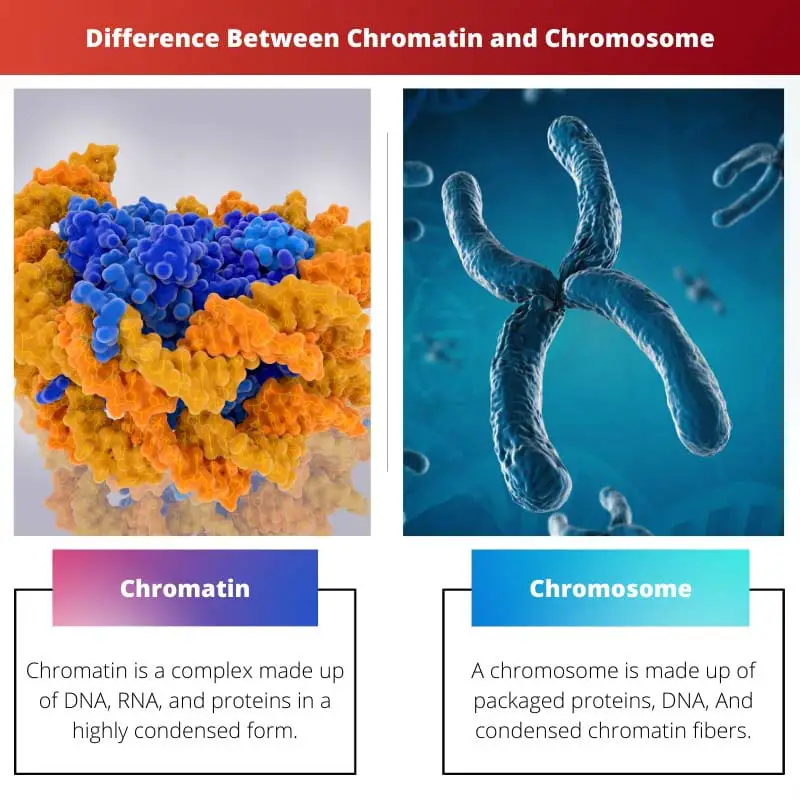Chromatin is a complex formed by Nucleic acid and protein and is found in eukaryotic cells. Chromatin is composed of Nucleosomes.
Chromosomes are a complex that came into existence through packaged proteins and DNA. Chromosomes are constituted of condensed chromatin fibre.
Key Takeaways
- Chromatin is a complex of DNA and proteins that make up the genetic material in eukaryotic cells.
- The chromosome is a condensed and organized chromatin form visible during cell division.
- Chromatin can be further condensed into chromosomes during cell division.
Chromatin vs Chromosome
Chromatin is the complex of DNA, RNA, and proteins that make up the genetic material within the nucleus of eukaryotic cells. A chromosome is a highly organized and condensed structure of DNA and protein formed by chromatin coiling and packaging during the cell cycle.

Chromatin originated from DNA, RNA, and proteins called Histones. Histones have a bead-like structure over a string when viewed through a microscope.
We can say Chromatin is the base for the formation of Chromosomes that are found in the nucleus of the eukaryotic cells. Chromatin comes in a highly condensed form.
Chromosomes are made up of packaged proteins and genes (DNA). As we have mentioned above, Chromosomes that are formed out of DNA have tightly coiled around in a string-like structure
with a protein called Histones that keeps the structure of chromosomes intact. A human body contains a total number of 23 pairs of Chromosomes.
Comparison Table
| Parameters of Comparison | Chromatin | Chromosome |
|---|---|---|
| Definition | Chromatin is a complex made up of DNA, RNA, and proteins in a highly condensed form. | A chromosome is made up of packaged proteins, DNA, And condensed chromatin fibers. |
| Structure | A structure like beads on a string. | Thread-like structure. |
| Function | DNA packaging, DNA Repair, and transcription of genetic information. | Storing genetic information and protecting the information during the process of cell division. |
| Elements | DNA, RNA, and proteins. | DNA, packaged proteins, and Chromatin fibers. |
| Quantity | 46 pairs. | 23 pairs. |
What is Chromatin?
Chromatin is a genetic material present in the nucleus of a eukaryotic cell. Protein, DNA, and RNA are the roots in the formation of Chromatin. There are two types of Chromatin mentioned below.
Euchromatin
Euchromatin is a type of Chromatin that is less condensed and can be easily transcribed. Euchromatin makes up 92% part of the human genome.
It appears to be a light stain under an optical microscope. It is mentioned that euchromatin has a structure of an unfolded set of beads on a string.
As stated above, euchromatin plays an active role in transcribing genetic information through a process while binding to the DNA sequence and aids in the replication process of DNA.
Heterochromatin
Heterochromatin is a type of Chromatin that is highly condensed and thus cannot be useful in the process of transcribing genetic information.
Heterochromatin is tightly packed and darkly stained when compared to euchromatin, which is equally opposed to this term.
We know from the above-mentioned information that euchromatin makes up 92% of the human genome, while the remaining consists of heterochromatin.
Coming to the heterochromatin structure is a 30-nm fibre coiled in the form of a helix measuring 30nm in diameter.
The fact that it is highly stained and tightly packed makes it appropriate to be seen while observing through an optical microscope.
Heterochromatin can also be condensed further into metaphase chromosomes and active chromosomes. Heterochromatin is of two types.
The first one is constitutive, while the other one is facultative.
What is Chromosome?
A chromosome is a genetic material in a body made up of packaged proteins and DNA. Chromosomes appear in the nucleus of a cell.
It is a long DNA molecule that stores genetic information and further replicates it for the process of cell division. Chromosomes have a thread-like structure that keeps the DNA intact with the proteins called Histones.
It helps in the proper arrangement of DNA to fit in the cell.
It is necessary for the DNA to remain intact because when the process of cell division takes place, the information getting replicated through DNA must be exactly copied and equally distributed to the numbers of cells.
If any mistake occurs in this process, which may result in any change in the structure of Chromosomes can lead to severe problems.
A human body contains 23 pairs of Chromosomes, from which 22 pairs of chromosomes are called autosomes, and one pair is of sex chromosomes that are X and Y.
Sex Chromosomes are responsible for the sex of the offspring that gets one of the sex chromosomes from both mother and father.

Main Differences Between Chromatin and Chromosome
- Chromatin contains unpackaged proteins, RNA and DNA, while chromosomes contain packaged proteins and DNA.
- Chromatin gets condensed through different phases as compared to chromosomes. Chromosomes are condensed throughout the various stages of mitosis.
- Chromatin is responsible for packaging DNA, while chromosomes are responsible for carrying genetic information.
- Chromatin is a bead-like structure over a string, and Chromosomes are thread-like structures.
- There are 46 chromatins in a G-1 phase. On the other side, the human body has 23 pairs of chromosomes.





